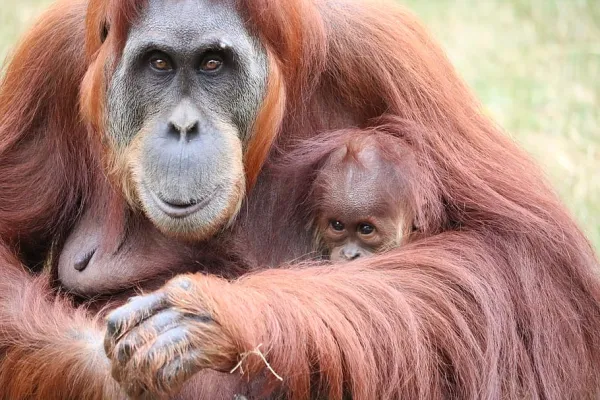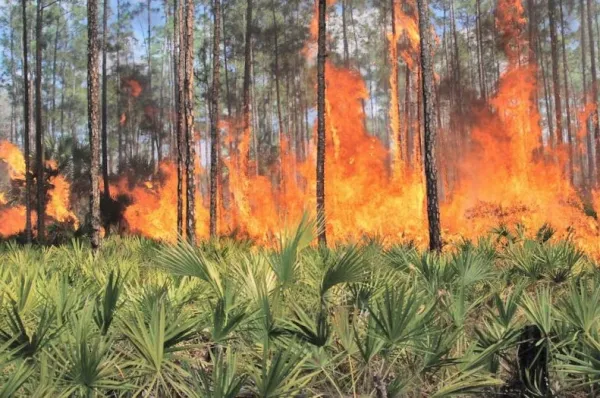Orangutans are great apes belonging to the genus Pongo, the order Primates, and the class Mammalia. There are three recognized species of orangutans native to Southeast Asia: the Bornean orangutan (Pongo pygmaeus), the Sumatran orangutan (Pongo abelii), and the Tapanuli orangutan (Pongo tapanuliensis). These apes are known for their long reddish-brown hair, herbivorous diet, and extremely long arms. They are mostly arboreal, can weigh between 30 and over 120 kg, and measure between 1.2 and 2 meters tall—making them the second-largest primates in the world, after gorillas.

Orangutans share more than 96% of their DNA with humans. Their intelligence is remarkable; they are capable of crafting and using tools and can even learn to communicate through sign language and lexigrams. In captivity, they can live over 60 years.
Sadly, these extraordinary animals are on the brink of extinction. This article explores why orangutans are endangered, how many remain in the wild, the main threats to their survival, and how we can help prevent their extinction.
Yes. Over the past 30–40 years, the global orangutan population has declined by 50% to 80%. The International Union for Conservation of Nature (IUCN) classifies all three species as Critically Endangered, meaning they face an extremely high risk of extinction in the wild or entirely in the near future.
Bornean orangutans: Estimated at around 55,000 in 2004 and decreasing (IUCN, updated in 2016).
Sumatran orangutans: Estimated at nearly 13,600 and decreasing (IUCN, 2017).
Tapanuli orangutans: Fewer than 800 individuals remain (IUCN, 2017).
More optimistic figures from the WWF estimate that the Bornean population may now exceed 104,000 and the Sumatran population over 13,800. Nonetheless, the threat of extinction remains critical and imminent.

The leading cause of orangutan population decline is illegal hunting and wildlife trafficking. An estimated 2,000–3,000 orangutans are killed each year. For every baby orangutan successfully captured and sold, up to three others die during capture and transport.
Even though Indonesian and Malaysian laws prohibit capturing or killing orangutans, and CITES restricts their trade, enforcement remains weak. Orangutans are hunted for trophies, traditional medicine, amulets, or meat. In some cultures, their body parts are believed to have mystical or aphrodisiac properties.
Most trafficked orangutans are infants separated from their mothers and sold on the black market for thousands of dollars to circuses or exotic pet collectors.
Massive deforestation in Indonesia and Malaysia has destroyed large portions of orangutan habitat. Forests are cleared to make way for agriculture, palm oil plantations, mining, and urban development. Key industries contributing to this destruction include:
Palm oil
Logging
Rubber production
Rice farming
Petroleum extraction
This habitat loss isolates orangutan populations, reducing mating opportunities, increasing competition for food, and weakening genetic diversity. Orangutans also suffer injuries or death due to construction machinery and man-made forest fires.
Orangutans have one of the lowest reproductive rates among mammals:
Females reach sexual maturity at ~11 years.
First offspring typically born around age 14.
Each female may only give birth to 4–5 offspring in her lifetime.
Gestation lasts 8–9 months.
Infants remain dependent on their mothers for 5–11 years.
If a nursing female mates, pregnancy is unlikely. If a baby loses its mother before age 5, survival chances are minimal. While male orangutans may force mating, they rarely commit infanticide, unlike some other species.
Climate change further endangers orangutans by:
Raising temperatures
Reducing rainfall
Causing droughts and forest fires
Degrading soil and food sources
These effects reduce habitat size, fragment populations, and lead to water and food scarcity—weakening orangutans and increasing disease and mortality.

Human intervention is vital. Without immediate conservation action, orangutans could disappear by 2050. Here’s how we can help:
Reforest damaged lands to restore habitat.
Create new and larger protected areas where orangutans can thrive.
Fund orangutan breeding and rehabilitation programs.
Regulate industries (agriculture, mining, energy, construction) that destroy habitats.
Enforce strict penalties for hunting and trafficking orangutans.
Support wildlife conservation organizations through donations, volunteering, and spreading awareness.
Adopt sustainable habits: Choose products that are palm-oil-free or contain sustainably produced palm oil.
Reduce waste and pollution, recycle more, and support eco-friendly brands.
These small efforts can make a big difference in the fight to save orangutans.
Orangutans are not just icons of the rainforest; they are vital to the health of their ecosystems. Losing them would be a tragedy for biodiversity and humanity. It’s not too late—join the movement to protect these gentle forest giants.
If you enjoyed this article, explore more content in our Endangered Animals section and help raise awareness for species that need our voice.
References
Abraham Alonso. (July 11, 2016). Muy Interesante Magazine. Bornean orangutans, critically endangered: https://www.muyinteresante.es/naturaleza/articulo/los-orangutanes-de-borneo-en-peligro-critico-111468223466
MV, SAW, HK/SJ/HR. (February 15, 2018). Max Planck Institute for Evolutionary Anthropology. Dramatic decline of Bornean orangutans: https://www.mpg.de/11939623/orang-utans-decline
Alec Forssmann. (February 15, 2018). National Geographic, Spain. The Bornean orangutan population has lost more than 100,000 animals in the last 16 years: https://www.nationalgeographic.com.es/naturaleza/actualidad/poblacion-orangutanes-borneo-perdido-mas-100000-animales-los-ultimos-anos_12394
Ancrenaz, M., Gumal, M., Marshall, A.J., Meijaard, E., Wich, S.A. & Husson, S. 2016. Pongo pygmaeus (errata version published in 2018). The IUCN Red List of Threatened Species 2016: e.T17975A123809220: https://www.iucnredlist.org/species/17975/123809220
Singleton, I., Wich, S.A., Nowak, M., Usher, G. & Utami-Atmoko, S.S. 2017. Pongo abelii (errata version published in 2018). The IUCN Red List of Threatened Species 2017: e.T121097935A123797627: https://www.iucnredlist.org/species/121097935/123797627
Nowak, M.G., Rianti, P., Wich , S.A., Meijaard, E. & Fredriksson, G. 2017. Pongo tapanuliensis. The IUCN Red List of Threatened Species 2017: e.T120588639A120588662: https://www.iucnredlist.org/species/120588639/120588662
World Wide Fund for Nature (WWF). SPECIES AND HABITATS: ORANGUTAN: https://www.wwf.es/nuestro_trabajo/especies_y_habitats/orangutan/
animal tags: Orangutans
We created this article in conjunction with AI technology, then made sure it was fact-checked and edited by a Animals Top editor.